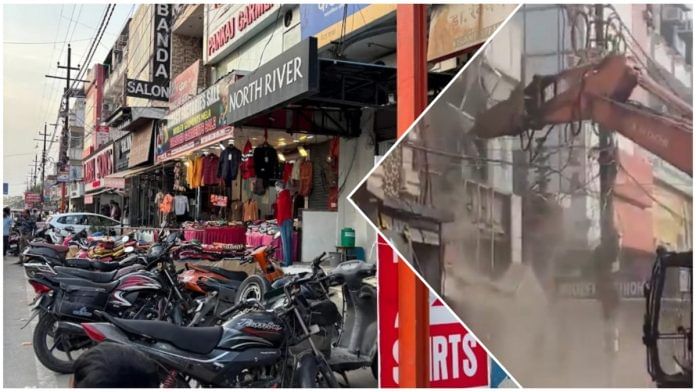Meerut: What was a stretch of scrubland 35 years ago grew organically into Shastri Nagar Central Market. Residents called it Meerut’s Connaught Place. But the shopping complex was built on land meant for Avas Vikas Parishad affordable housing and became a thorn in the side of some residents. After years of notices, non-compliance, and court cases, the Yogi Adityanath government’s bulldozers finally took over.
On the morning of 25 October, Awas Vikas Parishad bulldozers rolled in. Over two days, they razed 22 businesses — chai stalls, bridalwear shops, medical clinics — as crowds gathered and shopkeepers wept silently. It looked like the beginning of the end of a busy marketplace that kept Meerut’s economic engines turning. Overall, over 1,400 such constructions were marked for demolition. The action came after a case that wound through local courts for years before the Supreme Court, in 2024, ordered the housing board to reclaim the 7,000 sq metres of land, calling it “unauthorised commercial use of residential plots”.
“Everything turned into dust within minutes,” said 66-year-old Anand Kumar, holding his granddaughter close, as he stood near the rubble a day after demolition. A resident since 1986, he had seen the area grow from a quiet neighbourhood into a crowded bazaar visited by people not just from Meerut but other nearby towns as well. “The whole building was trembling. The walls cracked, and within minutes, it collapsed into piles of stones and dust.”
While traders’ earlier pleas to Chief Minister Yogi Adityanath were rejected, officials are now offering a patchwork fix in the wake of protests— letting traders set up temporary stalls on the same land. Plans are reportedly afoot to designate Shastri Nagar Central Market as a ‘market street’, a proposal for which will be presented to the Meerut Development Authority.
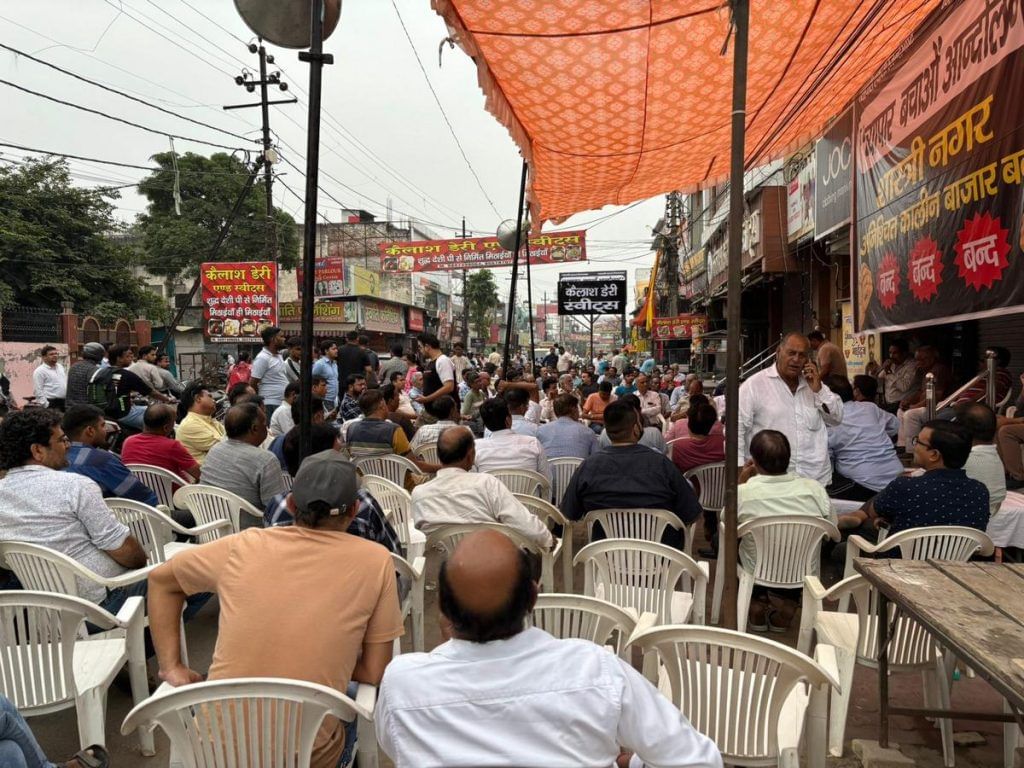
It’s a familiar trajectory. Last week, bulldozers rolled into Varanasi’s Dalmandi market to mow down over 180 structures, including six mosques, for a road-widening project. In Delhi’s Sarojini Nagar, over a hundred ‘illegal’ shops were razed earlier this year. It is part of a wider urban ritual of bulldozers belatedly doing the work meant for planners. Authorities let ‘encroachments’ and illegal markets grow for decades, then move in with bulldozers when court orders or other pressures finally catch up.
In the case of Shastri Market, the central issue was land use.
“In cities across the world, mixed land use is recognised as a local economic driver. It generates employment, reduces commuting for migrant workers, and sustains neighbourhood economies” said urban planner Tikender Panwar, former deputy mayor of Shimla and Kerala Urban Commission member. “People have transformed spaces for survival, the planning authorities just failed to catch up. If a market has existed for more than 20-30 years, that means it’s working for someone. The question we need to ask is: are we protecting livelihood?”
Also Read: The politicians who built Delhi’s Wazirpur slum. Its jhuggi to JCB story
Who complained?
Shastri Nagar resident Lokesh Khurana is nervous. He knows many traders blame him for what happened.
A social worker and RTI activist, Khurana watched the colony’s housing area shrink over the years as plots of the Avas Vikas Parishad (Uttar Pradesh Housing and Development Board) illegally turned into commercial complexes. A decade ago, he decided to do something about it after a 2013 demolition order from the Allahabad high court went ignored.
First, he petitioned the divisional commissioner in 2014, but it was only two years later that the district magistrate ordered officials to act under Section 133 of the CrPC, treating the markets as a public nuisance. Still, nothing changed, and so Khurana filed a contempt petition in the Supreme Court, after which the order came last year.
“I fear for my life,” said Khurana softly. He had to act, he added, because his neighbourhood had become dusty, polluted, and unliveable. But he insists he doesn’t blame the traders— he has bought groceries, utensils, and clothes from them. What he has a problem with is how institutions like Awas Vikas Parishad, the police, and the local administration looked away for years.
“Now, suddenly everybody remembers the law. But, where were they when this market was being built?” he said.
In December 2024, the Supreme Court upheld the High Court’s decision to raze unauthorised commercial constructions and dismissed the appeals of traders. Subsequently, Meerut authorities identified 1,478 plots in Shastri Nagar, as well as others in nearby colonies like Jagriti Vihar and Madhav Puram.
Mixed land use is the need of the hour. If you don’t plan for it, people will create it. It’s tied to their right to livelihood and right to live. Now, decisions are taken by administrations, not qualified professionals
-Anil Dewan, former dean (Research) at School of Planning and Architecture
The traders were left with no recourse. They met the chief secretary, Avas Vikas officials, even Chief Minister Yogi Adityanath. Everyone said the same thing: “Supreme Court ka order hai.”
By the time the JCBs arrived that Saturday morning, the market already knew what was coming. Chairs, desks, leftover Diwali stock, and bridal wear for the upcoming wedding season had been taken to safety. Then the process started: electricity was cut off and earthmovers clawed into the concrete. The shutters rattled, the tin roof cracked and fell, piece by piece.
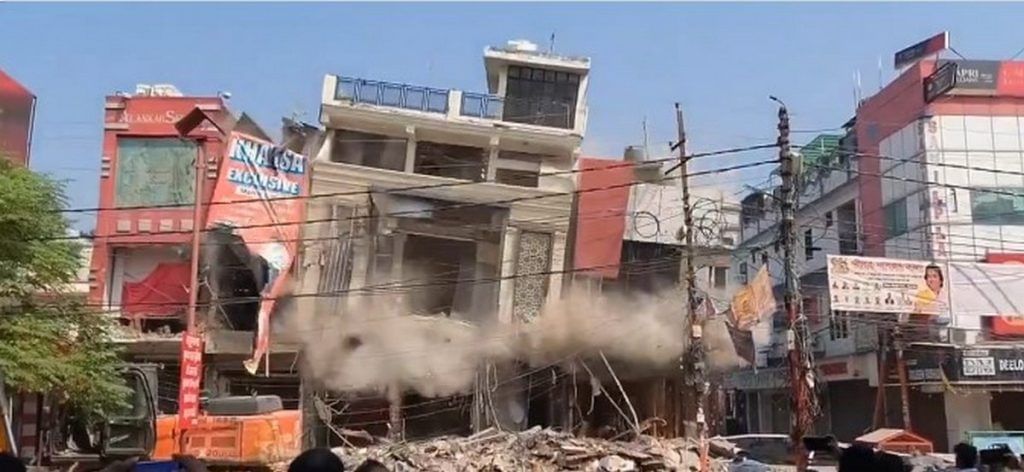
“The action was carried out under the Supreme Court orders,” said Meerut SSP Vipin Tada. “Police and fire officials were deployed to ensure smooth and safe operation.”
Around 250 police personnel from Civil Lines, PAC, and Traffic stood by but no one tried to obstruct the demolition.
By afternoon, rubble had replaced a row of bustling shops, with only crumpled hoardings and the odd cash register left.
An ‘iron hand’ – after over 30 years
The spectre of demolition had been hovering for a long time. The dispute dates back nearly forty years, to when the state housing department allotted land in Shastri Nagar for housing in 1986.
Possession was handed over in 1989, but soon after, commercial shops were built on the plot without any sanctioned plan or approval.
The complex of 22 shops that was demolished began as a single 288 sq m residential plot allotted to a dairy farmer called Veer Singh in the late 1980s. In 1990, it was transferred through a power of attorney to Vinod Arora, who converted it into a small commercial block. Others followed the same pattern, and over time, the sprawl grew into what became the Shastri Nagar Central Market.
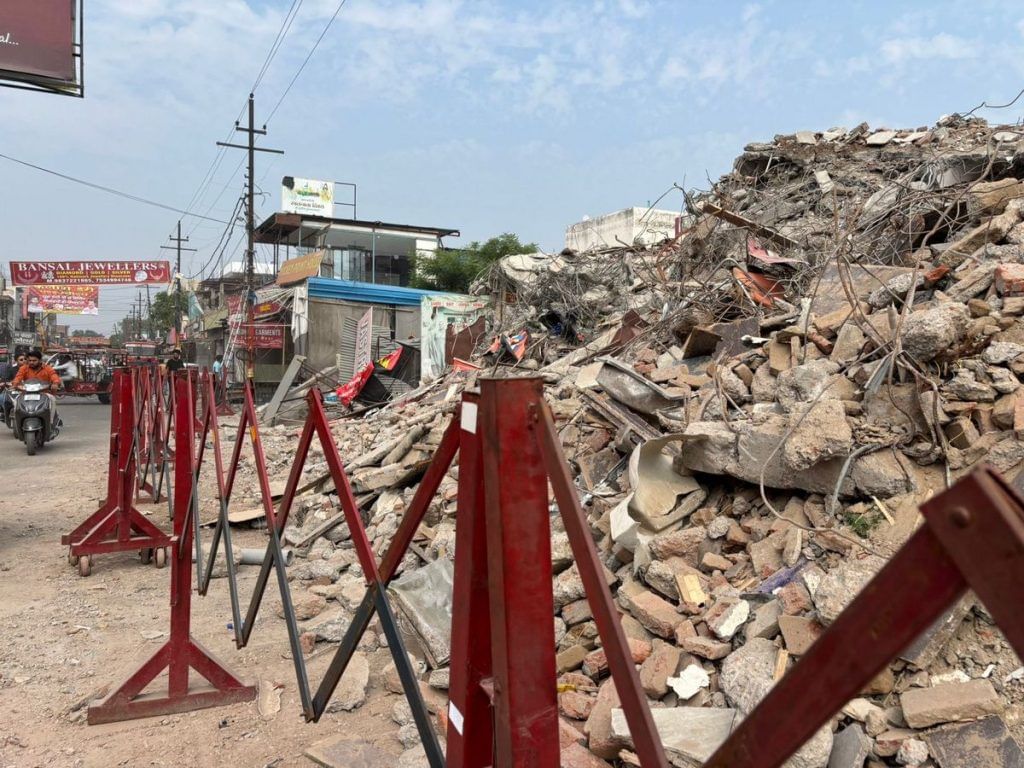
Between 1990 and 2013, the housing board kept issuing notices for unauthorised construction, but no one acted. The first demolition order was signed in March 2005 but not executed. Local officials largely looked away.
But the Supreme Court ruling, delivered by Justices JB Pardiwala and R Mahadevan, left little room for manoeuvre.
“An illegal act, more so, when it was done deliberately, does not become legal only because certain length of time has passed,” the court noted.
It also had stern words for the authorities across levels.
“The State Governments often seek to enrich themselves through the process of regularisation by condoning/ratifying the violations and illegalities, “ it observed. “[T]he officials who are responsible for ensuring planned land development… themselves start colluding with the land mafias.”
We built this bazaar ourselves. Each shop fed people. We pay commercial tax, electricity at Rs 14 a unit. How can they call this residential?
-Kishor Wadhwa, trader at Shastri Nagar Market
The judges rejected pleas for regularisation, stating that no trade or business licences should be issued to unauthorised buildings, whether commercial or residential. They also directed the state to penalise officials involved in the violations. Every deviation from the master plan, it reinforced, must be dealt “with an iron hand and not kid gloves”.
A survey conducted after the ruling revealed the scale of the problem. In Shastri Nagar’s thirteen sectors, 5,409 residential plots were examined, of which 860 were being used commercially, and only 230 were officially sanctioned.

A flurry of activity has ensued. At least three new FIRs were registered at Nauchandi police station in October. The first accused at least 45 Avas Vikas officials under sections 217 and 218 of the Bharatiya Nyaya Sanhita for negligence and dereliction of duty. A departmental inquiry found 53 employees guilty of allowing or ignoring the illegal construction.
Another FIR accused 22 traders of obstructing demolition, endangering lives, and assaulting staff. Among those named were Veer Singh, Rajkumar Bajaj, and Rajiv Gupta. All of their families had long been part of the market.
The third FIR, dated October 17, has named 22 Housing Board officers for “failing to prevent illegal construction” despite repeated court orders.
Around 90- 95 shopkeepers received notices this month.
“Notices have been issued to other properties in violation,” said Rajiv Kumar, superintendent engineer of Avas Vikas Parishad. He added that the operation had been delayed for years by court stays, but “the Supreme Court’s order will now apply across India.”
But there already seems to be movement back to the status quo
‘Humanitarian crisis’ goes to Yogi
With the demolition dust still hanging in the air, the market shut down in protest. Traders tied black ribbons to their sleeves and gathered outside a sweet shop called Kailash Mishthan, shouting, “Vyapari ekta zindabad! Eent se eent baja denge”— Long live trader unity! We’ll bring the whole system down, brick by brick!
Anger ran deep in Shastri Nagar, a BJP stronghold where Minister of State for Energy Somendra Tomar has a home. Traders accused the party of abandoning them.
“They told us it’s the Supreme Court’s decision,” one protester said. “When they wanted votes, we voted for them; when they wanted chanda (donation), we gave. Now, when we need them, no one comes to our doorstep.”
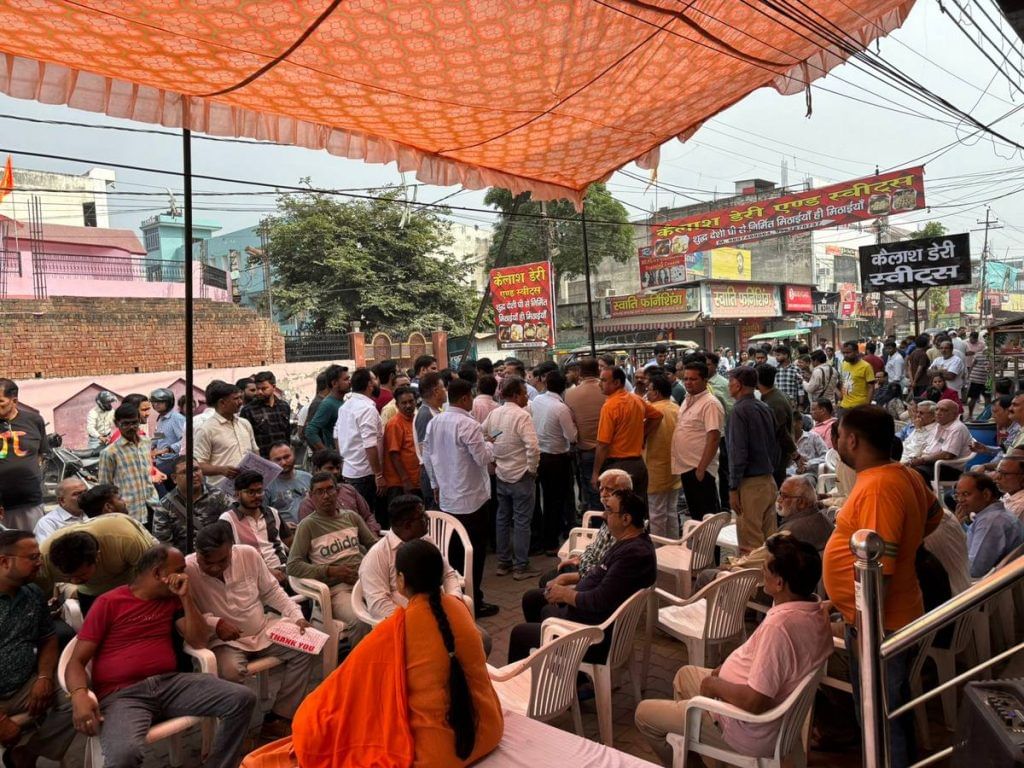
One oft-repeated slogan was: Sarkar ko dikhana padega apni taakat—we have to show the government our strength. Days later, it seems to have worked.
Last week, MP Arun Govil and MLA Amit Agarwal turned up at the dharna with a slate of assurances. They said no action would be taken against the 31 other constructions feared to be next, and that these would be given commercial status under a new land-use policy.
For the already demolished complex on Plot 661/6, Govil said he was pursuing rehabilitation for those affected. He also met Chief Minister Yogi Adityanath in Lucknow, apprising him of the “serious humanitarian crisis”.
“A meeting was held with the esteemed Chief Minister Shri Yogi Adityanath Ji to discuss the resolution of the traders’ issues. Following the discussions, the Meerut district administration provided significant relief to the traders,” Govil posted on X.
सेन्ट्रल मार्केट में स्थित कोम्पलेक्स 661/6 की बाईस दुकानों के सुप्रीम कोर्ट के ध्वस्तीकरण के बाद सेन्ट्रल मार्केट अनिश्चित काल के लिए व्यापारियों द्वारा बन्द कर दिया गया था। इस संबंध में प्रदेश के यशस्वी मुख्यमंत्री श्री योगी आदित्यनाथ जी से मिलकर व्यापारियों की समस्याओं के… pic.twitter.com/hx0A7OqCbQ
— Arun Govil (@arungovil12) October 28, 2025
Officials said the proposal to mark Shastri Nagar Central Market as a commercial street would be taken up in the next Meerut Development Authority meeting.
The strike ended with firecrackers and laddoos.
“Our discussions with government officials are underway, and we are trying to frame policy-level intervention to prevent similar disputes in future. We are engaging at local levels,” Tomar, who also serves as vice chairperson of the Meerut Development Authority, told ThePrint.
The shop owners are now demanding a law expanding mixed land use. Though Uttar Pradesh introduced new by-laws in July 2025 allowing up to 49 per cent commercial use on residential plots if conditions like road width are met, they want more flexibility.
“We don’t oppose the Supreme Court or the Avas Vikas Yojana,” said Sonia Rastogi, 33, a department store owner who has also been served a notice. “We just want relief.”
Law vs livelihood
India’s older markets, like the one in Meerut, evolved around mandis for loha, gud, and gehu. They all practiced a mixed model. Shops below, and homes above. It’s what urban planner Anil Dewan calls organic planning.
This is also how Old Delhi’s markets— Chandni Chowk, Katra Neel, Dariba Kalan, and Kinari—grew with their maze of lanes and thousands of shops on which lakhs of people depend directly and indirectly. Or Varanasi’s Dalmandi, near the Kashi Vishwanath temple, where around 500 mostly Muslim traders are currently facing their own reckoning with bulldozer “harassment.”
“But now, decisions are taken by administrations, not qualified professionals,” said Dewan, former dean (Research) at School of Planning and Architecture.
Markets labelled “encroachments” on paper keep local economies well-fuelled. Not just traders, but transporters, rickshaw-pullers, builders, loaders, and food vendors.
Why is the term avedh nirman (illegal construction) being used against traders? It is as if we are using legal land to do illegal activities. Why are people being punished for opening a shop in their own land, even if it’s meant for a residence?
-Bhagwan Das, Bhagwan Das, president of the Delhi Hindustani Mercantile Association
“Government jobs may not guarantee employment, but our vyaparis (traders) did,” said Bhagwan Das, president of the 132-year-old Delhi Hindustani Mercantile Association. “Markets have jobs for all—those with degrees, and those without school certificates.”
Much as in Meerut, the old city’s entrepreneurial spirit is caught between law and livelihood. Earlier this month, the Municipal Corporation of Delhi sealed eight shops in Katra Neel after a Supreme Court order directing authorities to stop the commercial use of residential properties. A resident’s petition claimed such conversions caused congestion and safety risks.
The sealing triggered outrage among traders, who said it ignored Delhi’s planning legacy. Chief Minister Rekha Gupta and Chandni Chowk MP Praveen Khandelwal announced that the Delhi government would approach the Supreme Court against the move. They are arguing that the area has been designated for mixed or commercial use since the 1962 Master Plan of Delhi (MPD).
“Chandni Chowk is commercial. You can’t call a 400-year-old market a violation,” Khandelwal told the media.
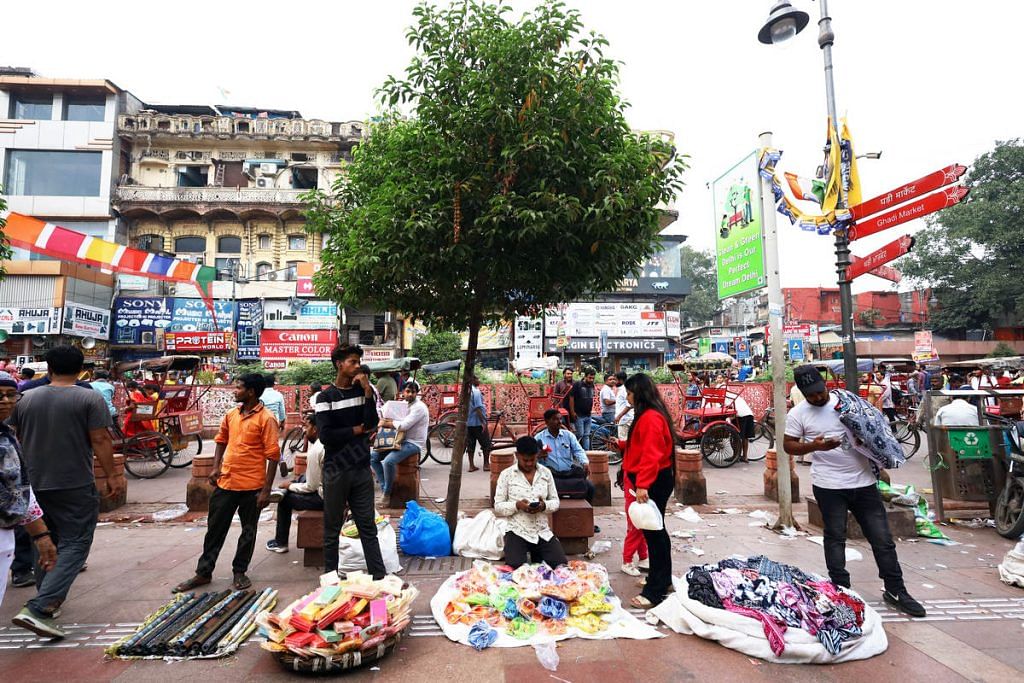
Land records support this claim. Gali Ghanteshwar is marked as a street-shopping lane in MPD 2021, and Katra Neel — once classified as mixed-use — is now fully commercial.
“Why is the term avedh nirman (illegal construction) being used against traders?” asked Bhagwan Das. “It is as if we are using legal land to do illegal activities. Why are people being punished for opening a shop in their own land, even if it’s meant for a residence?”
For planners such as Dewan, the recurring demolitions and sealing drives show how India’s rigid zoning ignores the way cities actually live.
“Cities like Singapore and Hong Kong have high-rise developments. They have parking in the basement, commercial activity at lower levels, offices above, and housing on the top floors,” he said.
But in India’s plans, there’s no space for the informal sector — the rehriwaala, dhobiwaala, small vendor, or domestic worker.
Mixed land use, which allows both residential and commercial activity on the same plot, is essential, according to Dewan
“Mixed land use is the need of the hour,” he said. “If you don’t plan for it, people will create it. It’s tied to their right to livelihood and right to live.”
Also Read: Sleepless in western UP. Everybody is panicking about drones
‘Work should not stop’
When 45-year-old Gaurav Vermani was a young child, there were only barren fields and half-built plots where the Shastri Nagar market now stands.
“Back then, there were only 30-40 families here. No lights, no shops, only fields,” recalled Vermani, who now runs the grocery store his grandfather started. The shop was among those that received a notice from the Awas Vikas authorities.
The area began changing in the late 1980s and early 1990s. The Hashimpura massacre of 1987, followed by the Babri Masjid demolition riots, pushed many families to move from the city’s tense old quarters to its quieter southern edge.

Cut off from supplies, residents began selling essentials such as grains, clothes, and medicines to each other. What began as a barter system turned into a line of makeshift shops.
“There were no jobs then,” Vermani recounted. “People from nearby villages, Hapur, Bulandshahr, and other places came here to work. That’s how the market and areas around Shastri Nagar grew.”
Over time, tin sheds became brick shops, and fields turned into a bazaar. The air smelled of fried snacks and diesel fumes. Shopfronts leaned into one another, boards advertised tailors, clinics, and the latest fashions.
It became one of Meerut’s many informal markets—like Soti Ganj, where car parts from across north India were dismantled and sold within hours, or Abu Lane and Begumpul, where traders dealt in brass, sports goods, and scrap. Shastri Nagar was a notch above as “Meerut’s CP.” Built not by planners, but by necessity, it became a place of opportunity.

Forty years ago, Kishore Wadhwa, now 64, rented a shop on the disputed plot for Rs 3,000 a month. By 1990, business was good enough for him to buy it for Rs 10 lakh. Today, he says, the space would fetch Rs 1.5 crore—had it not been reduced to dust.
“We built this bazaar ourselves. Each shop fed people,” Wadhwa said, tears welling up. “We pay commercial tax, electricity at Rs 14 a unit. How can they call this residential?”
Near a broken wall fenced off with yellow tape, 44-year-old Bhupender Kumar Sharma kept vigil in front of a clinic where he worked for the last 15 years. His task is to redirect patients who come here to JP Hospital where the “doctor saab” has shifted. The old clinic, run by Dr Sanjay Goel, had operated here for 35 years before it was razed.
“I’ve been standing here all day long. Doctor Saab will figure out jobs for each one of us,” he said. “Work should not stop.”
(Edited by Asavari Singh)



